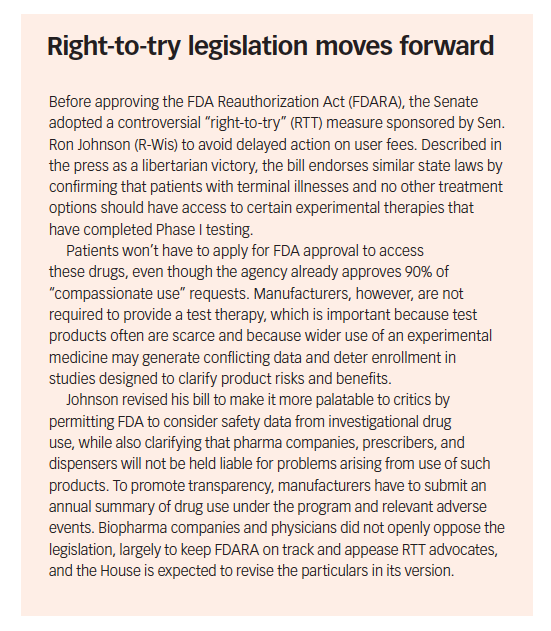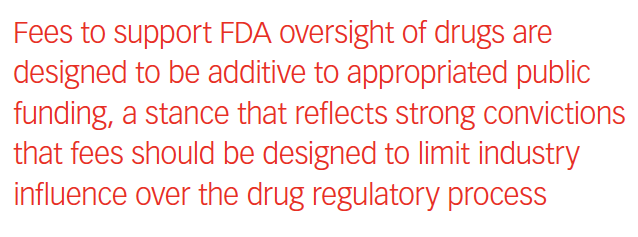FDA, Industry Prepare for New User Fee Initiatives
Pharmaceutical Executive
Drug pricing, right-to-try, opioids, and OTC improvements still on legislative agenda.
The Senate approved critical legislation early last month reauthorizing important five-year user fee programs that fund FDA review operations, just in time to avoid major agency disruptions. The bill was nearly derailed by contentious Senate debate over revising the Affordable Care Act (ACA), but once the wrangling over Obamacare fizzled out, the Senate quickly adopted the FDA Reauthorization Act (FDARA) that the House had approved in early July so it could be sent directly to the White House without further
Jill Wechsler

Congressional negotiations.
By enacting new fee programs for drugs, biologics, generic drugs, medical devices, and biosimilars before they expired on Sept. 30, Congress avoided FDA having to send layoff notices to more than 3,000 staffers supported by industry payments. The Trump administration had created uncertainty by demanding that industry pay much higher fees to fully support FDA review activities. But agency officials had been negotiating with industry representatives and other stakeholders for more than two years on user fee goals and program revisions, making it impossible to revise the agreed-on packages so late in the game. Fees to support FDA oversight of drugs and medical products, moreover, are designed to be additive to appropriated public funding of the agency, a stance that reflects strong convictions that fees should be designed to limit industry influence over the drug regulatory process.
To move the user fee package forward quickly, the Senate adopted a separate “right-to-try” bill (see sidebar below), even though FDARA includes language to broaden eligibility to clinical trials for very ill individuals. The Senate also approved separate measures backing wider use of patient-reported data in the drug approval process and standards for recording patient opioid use in medical records.
‘Clean’ bill
FDARA, thus, has relatively few policy riders, due both to the tight time-frame for enactment and to Congressional approval of the extensive 21st Century Cures Act last December. FDARA largely builds on existing FDA programs for accelerating approval of new and generic drugs. There are added incentives for developing pediatric cancer therapies and medical devices for children. One provision aims to limit orphan drug exclusivity awards for too-similar therapies, and another requires sponsors to conduct studies on new tropical disease treatments to qualify for relevant priority review vouchers. There’s language to deter import of counterfeit medicines and several measures designed to streamline development of innovative medical devices.
Efforts to lower prescription drug prices ended up focusing on strategies for speeding the development and marketing of generics. FDARA establishes a priority review track for “competitive generic therapies” and an accelerated development initiative offering more advisory meetings and fast facility inspections for certain products. Brand manufacturers have to update information on products withdrawn from the market as part of

an initiative for expanding information on drugs with limited competition.
The new five-year program funded by the Prescription Drug User Fee Act (PDUFA VI) restructures fees to collect more revenues from product fees, as opposed to applications, while continuing initiatives to accelerate the testing and development of new therapies. As the drug user fee program has reduced review times by increasing first cycle approvals, FDA and sponsors now are focusing on efforts to streamline the mushrooming demand for development-phase meetings, boost resources for the breakthrough drug program, advance the review process for rare disease treatments, and bolster support for combination products. In addition to added provisions for incorporating the “patient voice” into regulatory decision-making, there’s continued emphasis on advancing model-informed drug development, clarifying standards for biomarker qualification, and enhancing policies for using real-world evidence in regulatory decisions. PDUFA VI also increases resources to improve FDA’s electronic submission process and enhance IT initiatives, and to improve systems for hiring and retaining review staff.
The second version of the Generic Drug User Fee Amendments (GDUFA II) also changes its fee structure and operations, largely to accommodate the many small generic drugmakers with relatively few approved products, through lower application fees offset by higher program fees based on approved products and facilities. Stakeholders acknowledge that GDUFA has helped FDA improve the timeliness and predictability of generic drug application reviews and has reduced its formidable review backlog, and the revised program aims to continue those gains. Similarly, FDA’s biosimilar fee program (BSUFA II) bolsters annual program fees to support agency advisory efforts during product development.
More to come
A number of key issues failed to make it into FDARA, largely to avoid legislative delay. The Senate rejected a proposal to allow the import of less expensive drugs from Canada backed by Sen. Bernie Sanders (D-Vt). Earlier, House Democrats blocked provisions limiting FDA regulation of manufacturer communication related to unapproved uses, including clearer definition of “intended use” and “scientific exchange” and more leeway for providing economic information and alerts on pending product approvals to payers and formulary committees.

FDA has recently moved forward with a proposal for establishing user fees to support expedited review and approval of over-the-counter (OTC) drugs, too late to be included in FDARA but likely to gain Congressional approval in the near future. FDA unveiled its OTC reform plan in August, and hearings in the House are expected this month.
Generics makers backed a measure to facilitate access to branded drugs needed for bioequivalence testing but withheld under innovator restricted distribution programs. The issue will be part of broader consideration and debate on drug pricing and access. FDARA already includes language that calls for legislative action to lower drug prices, and several proposals before Congress aim to do just that. More are in the works and likely to be combined with legislation on access to experimental therapies and to opioid-rescue treatments, as well as other strategies for curbing opioid abuse.
Jill Wechsler is Pharmaceutical Executive’s Washington Correspondent. She can be reached at jllwechsler7@gmail.com

Navigating Distrust: Pharma in the Age of Social Media
February 18th 2025Ian Baer, Founder and CEO of Sooth, discusses how the growing distrust in social media will impact industry marketing strategies and the relationships between pharmaceutical companies and the patients they aim to serve. He also explains dark social, how to combat misinformation, closing the trust gap, and more.
FDA Grants Priority Review to Regeneron’s Eylea for Macular Edema Following Retinal Vein Occlusion
April 18th 2025Regulatory action was based on data from the Phase III QUASAR trial, which demonstrated that Eylea HD dosed every eight weeks achieved non-inferior visual acuity outcomes compared to Eylea in patients with macular edema following retinal vein occlusion.